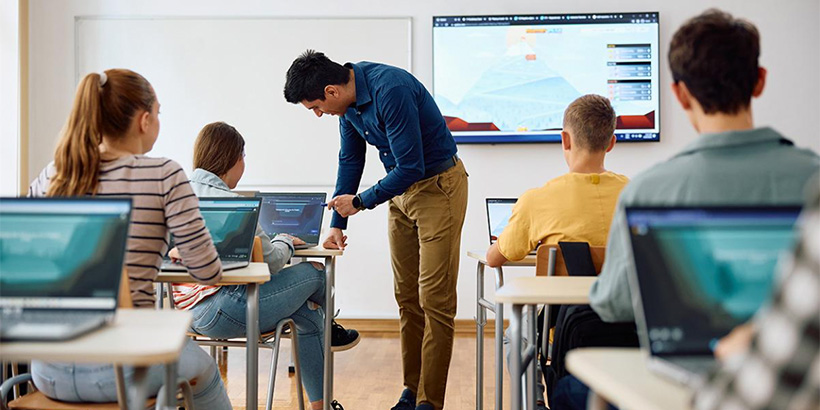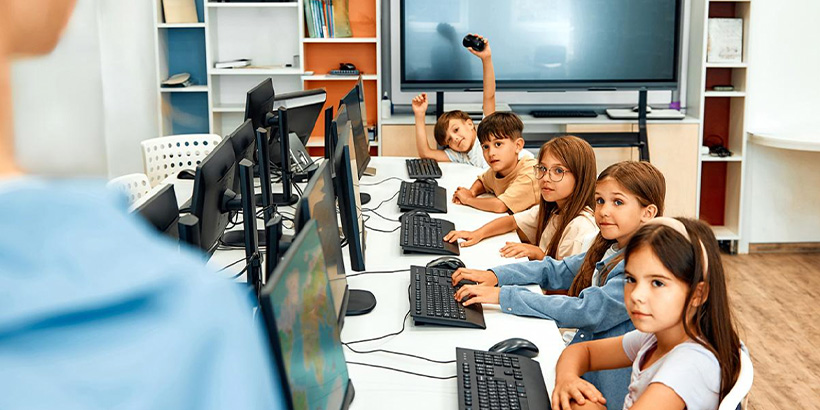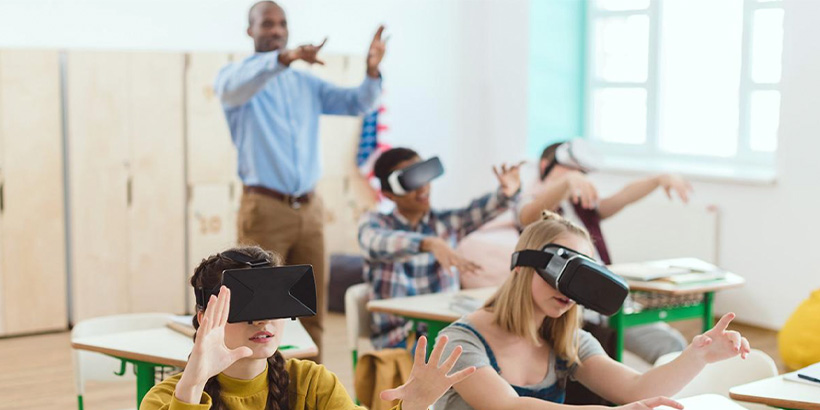Integrating Technology in the Classroom For 2025

Integrating technology into your teaching practice is no longer an optional enhancement, but a necessity in the modern educational landscape. As educational technology evolves, so do teaching methods, allowing for more engaging, efficient, and effective educational experiences.
We'll explore the many benefits of effective technology integration in the classroom,
look at various educational apps and technology tools to engage all learning styles,
and provide strategies and best practices for leveraging technology to enhance student
engagement.
The Benefits of Integrating Technology in Teaching

The use of technology by children has sparked considerable debate among educators, parents, and researchers. While technology offers numerous educational benefits and opportunities for engagement, it also poses challenges and potential risks that need to be carefully managed.
When used appropriately, technology can open up a world of educational opportunities for children. Educational apps, online courses, and interactive learning tools can make learning more engaging and accessible. Here are some ways technology integration in the classroom can benefit students.
Enhanced Student Engagement
One of the most significant benefits of integrating technology into teaching is increased student engagement. Traditional teaching methods sometimes fall short in capturing students’ attention, but interactive digital tools and multimedia resources can make learning more exciting and interactive.
For instance, videos, animations, and interactive games can transform a mundane lesson into an immersive educational experience that keeps students actively engaged. This increased engagement often leads to better retention of information and deeper learning facilitated by technology.
Personalized Online Learning
Technology integration allows teachers to customize learning experiences to meet the needs of individual students. With adaptive learning software, teachers can differentiate instruction and tailor lessons to match the learning pace and style of each student. This personalized approach helps ensure that no student is left behind and that advanced learners are continually challenged.
Additionally, data analytics tools can provide teachers with insights into student performance, enabling them to identify areas where students may need additional support in meeting learning objectives.
Improved Collaboration and Communication
Digital tools facilitate better communication and collaboration among students and teachers. Platforms like Google Classroom, Microsoft Teams, and Zoom make it easy to share resources, submit assignments, and provide feedback. These tools also support collaborative projects, allowing students to work together on assignments regardless of their physical location. This fosters a sense of community and encourages the development of teamwork and communication skills, which are building blocks for future success.
Access to a Wealth of Resources
The internet is an abundant source of information, and integrating instructional technology
into teaching opens up access to an almost limitless number of resources. Teachers
can supplement their lessons with up-to-date information, diverse perspectives, and
varieties of multimedia content. Educational websites, online libraries, and digital
textbooks provide students with additional learning materials that enhance their understanding
of the subject matter. Internet access also helps promote critical thinking and research
skills.
Educational Apps and Technology Tools

The right technology tools can significantly enhance the learning experience, while the wrong ones can lead to frustration and wasted resources. Here are some top technological devices and software applications that help students meet learning objectives.
Learning Management Systems (LMS)
Instructional technology, such as Learning Management Systems like Canvas, Moodle, and Blackboard are essential tools for managing online courses and resources. These platforms allow teachers to organize course materials, track student progress, and facilitate communication. LMS platforms often include features such as discussion boards, quizzes, and grading systems, making them a comprehensive solution for online and hybrid learning environments.
Interactive Learning Apps
Apps like Kahoot!, Quizlet, and Nearpod are excellent for creating interactive learning experiences.
- Kahoot! allows teachers to create fun, competitive quizzes that engage students and reinforce learning.
- Quizlet offers various study tools, including flashcards and games, to help students review and retain information.
- Nearpod enables teachers to create interactive lessons with multimedia content, quizzes, and collaborative activities, making learning more dynamic and engaging.
Integrated technology in the classroom helps meet students' learning needs and enhances their interaction with the curriculum.
Educational Content Platforms
Platforms like Khan Academy, Coursera, and EdX provide high-quality educational content across a wide range of subjects.
- Khan Academy offers free instructional videos and practice exercises for students of all ages.
- Coursera and EdX partner with top universities to offer online courses, many of which are free or available at a low cost.
These platforms are invaluable resources for supplementing classroom instruction and providing students with additional learning opportunities.
Classroom Management Tools
Classroom management tools like ClassDojo and Seesaw help teachers streamline administrative tasks and communicate with students and parents.
- ClassDojo allows teachers to track student behavior, share updates with parents, and reward positive behavior.
- Seesaw provides a digital portfolio platform where students can showcase their work, receive feedback, and reflect on their learning progress.
These tools help create a more organized and supportive learning environment.
Strategies for Using Technology to Enhance Student Engagement and Learning
Even with the right technology tools, teachers must know how to utilize these tools to create meaningful and effective learning experiences for their students. Below are some strategies for how to use technology in the classroom.
Blended Learning
Blended learning combines traditional face-to-face instruction with online learning activities. This approach allows for a more flexible and personalized learning experience. Teachers can use online resources to supplement classroom instruction, provide additional practice, and offer opportunities for students to explore topics in greater depth.
Blended learning also enables teachers to use class time more effectively, focusing on interactive and hands-on activities that reinforce online learning. For successful technology integration, teachers need to be competent in using technology, be willing to embrace change, and have access to ongoing professional development.
Flipped Classroom
The flipped classroom model involves reversing the traditional teaching approach by having students learn new content at home through online videos and readings, and then using class time for interactive activities and discussions. This method allows students to learn at their own pace and provides more opportunities for active learning and collaboration in the classroom.
Teachers can use platforms like Edpuzzle and Screencastify to create and share instructional videos, making the flipped classroom model easy to implement. Incorporating technological pedagogical content can further enhance the effectiveness of this model.
Gamification
Gamification involves incorporating game elements into the learning process to increase motivation and engagement. Teachers can use educational games, quizzes, and challenges to make learning more fun and interactive. Platforms like Kahoot! and Quizizz allow teachers to create gamified quizzes that students can play individually or in teams. This approach not only makes learning more enjoyable but also helps reinforce key concepts and improve retention.
Project-Based Learning for Deeper Learning
Project-based learning (PBL) is a student-centered approach that involves working on real-world projects over an extended period. Technology can play a significant role in PBL by providing tools for research, collaboration, and presentation. Students can use online resources to gather information, collaborate with peers using digital tools, and create multimedia presentations to showcase their work.
PBL encourages critical thinking, creativity, and problem-solving skills, making it
a valuable strategy for enhancing student learning. Integrating frameworks such as
TPACK and SAMR can further enhance tech integration in PBL, ensuring a focus on pedagogy
and subject matter.
Tips for Successful Technology Integration

If you're new to integrating technology into the classroom, it may seem daunting at first. Here are some tips to help you get started.
Start Small
When integrating technology into your teaching practice, it's essential to start small and gradually build up your digital toolkit. Begin by incorporating one or two tools (such as interactive whiteboards or 1:1 devices for students) that align with your teaching goals and gradually introduce more as you become comfortable. This approach allows you to manage the learning curve and ensures that technology enhances rather than overwhelms your teaching.
Provide Clear Instructions and Support
While many older students (middle school and above) have their own mobile devices for access to social media platforms, educational technology may be less familiar to some students. Keep in mind that your students may have varying levels of familiarity with technology, so it's crucial to provide clear instructions and support.
Take the time to demonstrate how to use digital tools and offer step-by-step guides or tutorials. Be available to answer questions and provide assistance as needed. By ensuring that students feel confident using technology, you can help them focus on learning rather than struggling with technical issues.
Encourage Digital Citizenship
As students use technology more frequently, it's essential to teach them about digital citizenship. This includes understanding how to use technology responsibly, respecting others online, and protecting their privacy and security. Incorporate lessons on digital etiquette, online safety, and the ethical use of information into your curriculum. Encouraging good digital citizenship helps create a positive and respectful online learning environment.
Use Data Collection to Inform Instruction
Many digital tools provide valuable data on student performance and engagement. Use this data to inform your instruction and make data-driven decisions. Identify areas where students may be struggling and adjust your teaching strategies accordingly. Providing timely feedback on student work based on data can help students improve and achieve their learning goals. The Technology Integration Matrix can also be utilized to structure and enhance the integration of technology in your teaching practices.
Foster Collaboration and Communication
Encourage collaboration and communication among students using digital tools. Create
opportunities for group projects, discussions, and peer feedback. Use platforms like
Google Classroom or Microsoft Teams to facilitate communication and resource sharing.
Fostering a collaborative learning environment helps students develop essential skills
such as teamwork, communication, and problem-solving.
How a Master's in Teaching Program Can Help
Technology changes rapidly these days. If it's been a while since you earned your teaching degree, your pedagogical knowledge of technology integration may be limited. Pursuing an advanced degree such as a Master's in Teaching can help educators develop the skills and knowledge needed to effectively integrate technology into their classrooms and enhance their teaching practice.
Gaining Experience with Technology
Master’s in Teaching (MIT) programs often include coursework and practical experiences focused on integrating technology into teaching. These programs provide educators with the knowledge and skills needed to effectively use digital tools and resources in the classroom. Through hands-on experiences, such as designing and implementing technology-enhanced lessons, teachers gain confidence and proficiency in using technology to support student learning.
Staying Current with Educational Trends
MIT programs help teachers stay current with the latest educational trends and technologies. Faculty members often bring expertise in educational technology and stay up-to-date with emerging tools and best practices. This ensures that teachers are equipped with the most current knowledge and can effectively integrate new technologies into their teaching practice.
Building a Professional Network
Participating in a Master's in Teaching program provides opportunities to connect with other educators who are also interested in using technology to enhance learning. This professional network can be a valuable resource for sharing ideas, resources, and experiences. Collaborating with peers can lead to new insights and innovative approaches to integrating technology in the classroom.
Access to Resources and Support
Many MIT programs offer access to resources and support for integrating technology
into teaching. This may include workshops, seminars, and access to digital tools and
platforms. These resources can help teachers stay informed about the latest developments
in educational technology and provide ongoing support as they implement new tools
and strategies in their classrooms.
Perfect the Art of Technology Integration in the Classroom With a Master's in Teaching

Earning an advanced degree such as a Master's in Teaching equips educators with the tools, strategies, and confidence needed to leverage technology effectively in the classroom. By staying current with educational trends and mastering the latest digital tools, teachers can create more dynamic, engaging, and personalized learning experiences for their students.
The knowledge and skills gained through a comprehensive Master's program can transform teaching practices, making them more adaptable to the needs of today’s diverse and tech-savvy student population.
If you're passionate about enhancing your teaching practice and preparing for the future of education, consider pursuing a Master's in Teaching from Pepperdine University. With a strong emphasis on technology integration, Pepperdine's program offers the expertise and support needed to become a leader in modern education.
Take the next step in your professional journey and discover how a Master's in Teaching from Pepperdine can empower you to make a lasting impact in your classroom.